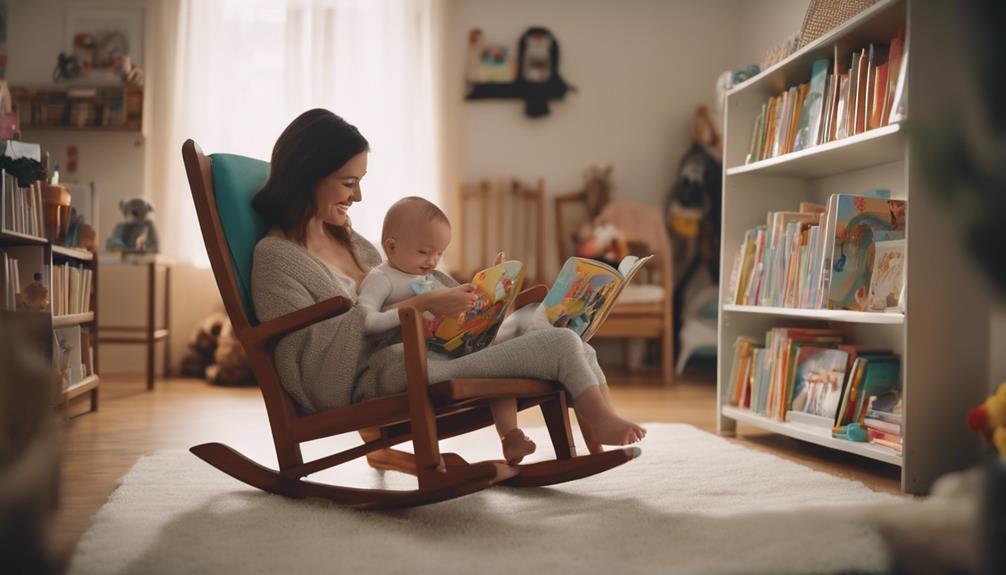Reading to your baby is crucial for establishing a solid foundation for their early development. Exposure to books can improve language skills, enhance observation abilities, and support emotional growth. By interacting with books, you are helping to create neural connections, boost cognitive abilities, and expand vocabulary for future success. Different types of books are available for different stages of development, from tactile books for infants to interactive stories for toddlers. Through reading, you are not only nurturing a passion for learning but also forming a special bond with your child. Continue to explore to learn more about the countless benefits of this enriching experience.
Key Takeaways
- Reading to babies enhances language skills and cognitive development from an early age.
- Bonding through reading fosters emotional connection and secure attachment between parent and child.
- Selecting age-appropriate books stimulates sensory and language development for optimal engagement.
- Reading sessions with infants cultivate a love for learning and exploration, laying the foundation for future academic success.
- Regular reading activities build essential communication skills, promoting literacy and cognitive abilities in the long term.
Importance of Reading to Babies
Reading to babies is vital for their early development and sets the foundation for a lifetime of learning and language skills. Children benefit greatly from being exposed to books from a young age, as it helps establish a strong foundation for their cognitive abilities. By engaging with books, infants' brains are stimulated, enhancing essential listening and observation skills during their formative years. This early exposure not only fosters emotional development but also instills a love for reading that can last a lifetime.
Research shows that babies who are read to early on have a 40% richer vocabulary by the time they reach 18 months old, which is critical for language acquisition and future language skills. Establishing a routine of reading with infants not only promotes language development but also creates a sense of closeness, security, and emotional connection between parent and child. By recognizing the importance of reading to babies, parents can play a significant role in laying the groundwork for their children's educational journey.
Benefits of Early Exposure to Books

Early exposure to books offers a myriad of benefits for your little one. It boosts cognitive development, improves language skills, and fosters bonding and connection between you and your baby.
Cognitive Development Boost
Introducing infants to books at a young age greatly improves their cognitive development by promoting brain growth and establishing important neural connections. Early exposure to books serves as a catalyst for stimulating brain development in babies, laying a solid foundation for their cognitive abilities.
By engaging with books from an early age, infants benefit from enhanced receptive vocabulary, leading to a 40% richer vocabulary by 18 months. This exposure not only boosts cognitive functions but also fosters language development and listening skills in young children. Regular reading sessions create a strong basis for literacy and future academic success.
Additionally, tactile books with textures and sounds cater to babies under 9 months, aiding in sensory and cognitive development. The cognitive benefits of introducing infants to books early on are substantial, shaping their neural pathways and setting the stage for robust cognitive growth.
Language Skills Improvement
Enhancing your baby's exposure to books from an early age not only enriches their vocabulary but also cultivates a strong foundation for improving language skills. Early literacy is crucial in developing language skills, and reading to your baby plays a fundamental role in this process. Introducing books to infants not only enhances their receptive vocabulary but also promotes language development and listening skills. By engaging in regular reading sessions, you are setting the stage for a solid literacy foundation that will benefit your baby's future language skills.
| Benefits of Early Exposure to Books |
|---|
| Enhances receptive vocabulary |
| Fosters language development |
| Promotes listening skills |
| Creates a strong foundation for literacy |
| Encourages interactive reading sessions |
Bonding and Connection
Reading to your baby creates a strong emotional bond, fostering intimacy and affection between you and your child. Studies have shown that this bonding experience plays an important role in your baby's emotional development.
By engaging in reading sessions from an early age, you're enhancing the parent-infant connection, which is essential for your baby's healthy development. The soothing sound of your voice as you read to your baby not only provides comfort but also helps in building a secure attachment and trust between you both.
This strong bond established through reading aids in your baby's emotional regulation and resilience, setting a foundation for healthy relationships in the future. Additionally, by fostering a secure attachment through reading, you're encouraging your baby to communicate emotions effectively, which is essential for their overall emotional well-being.
Bonding through books isn't just about the words on the pages but about the profound connection it cultivates between you and your little one.
Types of Books for Different Ages

Babies under 9 months are drawn to tactile books with textures and sounds, engaging their developing senses.
As children reach 9-18 months, see-and-say books aid in visual and auditory recognition.
Toddlers, aged 18 months to 2 years, enjoy rhyming books and simple plots that boost language development.
Age-Appropriate Book Selection
For babies under 9 months, selecting tactile books with textures and sounds can effectively stimulate their developing senses. As your little one explores these interactive books, they can enhance their sensory experiences and begin to form positive associations with reading.
Moving forward, consider the following age-appropriate book recommendations:
- Children aged 9-18 months: Introduce see-and-say books that help in learning simple concepts and new vocabulary.
- Toddlers (18 months to 2 years): Engage with rhyming books and simple plots to foster their language skills and keep them captivated.
- Transitioning to older toddlers: Try longer picture books with repetition to maintain their interest and aid in their cognitive development.
Interactive Reading Activities
Explore a variety of book types tailored to different age groups to enhance your child's interactive reading experiences. For babies under 9 months, tactile books with textures and sounds provide sensory exploration opportunities, fostering early interactive reading skills.
Children aged 9-18 months benefit from see-and-say books that boost visual and auditory abilities. Toddlers, between 18 months and 2 years old, enjoy rhyming books and simple plots that engage their growing language skills.
Introducing longer picture books with repetition can captivate the attention of some babies and toddlers, enhancing their interactive reading experiences. Encouraging interactive reading sessions as your child grows not only promotes engagement but also supports language development.
Engaging Babies Through Reading

When reading to your baby, utilize engaging techniques such as funny sound effects and songs to make the sessions interactive and enjoyable. Engaging babies through reading is vital in laying the foundation for future language development.
Here are three ways to make reading more engaging for your little one:
- Use Interactive Books:
Babies under 9 months enjoy tactile books with textures and sounds that they can explore with their senses. These interactive books not only capture their attention but also help in developing their sensory skills.
- Incorporate Songs and Sound Effects:
Adding funny sound effects or singing songs while reading can captivate your baby's interest and make the reading experience more interactive. This helps in keeping them engaged and excited about story-time.
- Choose Age-Appropriate Books:
Toddlers appreciate rhyming books and simple plots that are easy for them to follow. Selecting books tailored to your baby's age and developmental stage ensures they stay engaged and interested in the story.
Building Language Skills Through Reading

Enhancing your baby's language skills through reading provides a vital foundation for future literacy development. Reading to infants not only enhances their receptive vocabulary but also contributes to a 40% richer vocabulary by the time they reach 18 months.
Exposure to board books early on is particularly beneficial as it fosters language development and improves listening skills in babies. Regular reading sessions with infants play an essential role in laying the groundwork for their future literacy skills. Introducing a variety of board books tailored to specific age groups can engage babies in different ways, stimulating their language acquisition and cognitive abilities.
Transitioning to real story-time with toddlers involves encouraging participation, repeating favorite books, and gradually building their patience for longer story sessions. By building language skills through reading, you're equipping your child with essential communication skills that will benefit them throughout their lives.
Fostering a Love for Learning

Cultivating a passion for knowledge begins with nurturing a love for learning through early exposure to reading with infants. Introducing books to babies has long-term benefits that go beyond just literacy skills.
Here are three ways reading fosters a love for learning:
- Intellectual Stimulation: Reading sessions with infants create a stimulating environment that encourages brain development and curiosity. The exposure to different words, sounds, and ideas ignites a desire for exploration and learning in babies from an early age.
- Positive Attitude Towards Education: Early exposure to reading helps infants develop a positive attitude towards education. It sets a foundation for a lifelong appreciation of learning, making them more inclined to explore new concepts and ideas.
- Parent-Child Bonding: Engaging in reading activities with babies not only fosters a love for learning but also strengthens the bond between parent and child. The shared experience of reading creates a nurturing environment where learning is associated with love and connection.
Frequently Asked Questions
What Is the Strong Foundation of Reading?
To build a strong foundation of reading, focus on phonological awareness, print knowledge, and oral language skills. Mastering phonics, vocabulary, and fluency will enhance your ability to recognize words, spell correctly, and improve overall reading proficiency.
How Does Reading to Your Child Create a Bond?
Reading to your child creates a bond by fostering intimacy, security, and communication. Your soothing voice comforts them, building a strong emotional connection. Trust is nurtured through shared moments, laying the foundation for a healthy relationship.
When Should You Start Reading to a Baby?
You should start reading to a baby as early as possible. Hearing your voice promotes early brain development and language skills. Reading creates a strong bond, fosters emotional development, and sets the stage for a lifelong love of books.
How Much Should You Read to Your Baby?
You should read to your baby for at least 15 minutes a day. Reading helps with language development, vocabulary, and sets the stage for academic success. It's recommended to start reading to your baby from birth.
Conclusion
To sum up, reading to your baby is an essential step in building a strong foundation for their future development. By exposing them to books early on, you aren't only helping to enhance their language skills, but also fostering a love for learning that will benefit them throughout their lives.
Remember, it's never too early to start reading to your little one – the benefits are endless and the memories you create will last a lifetime. So grab a book and start building that foundation today!










